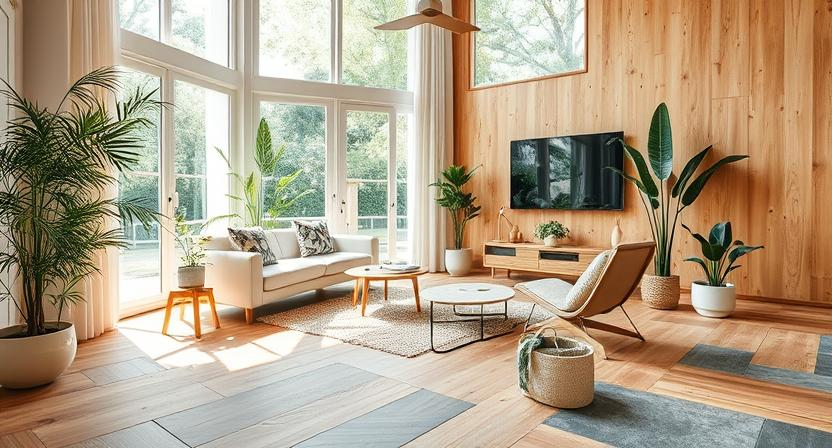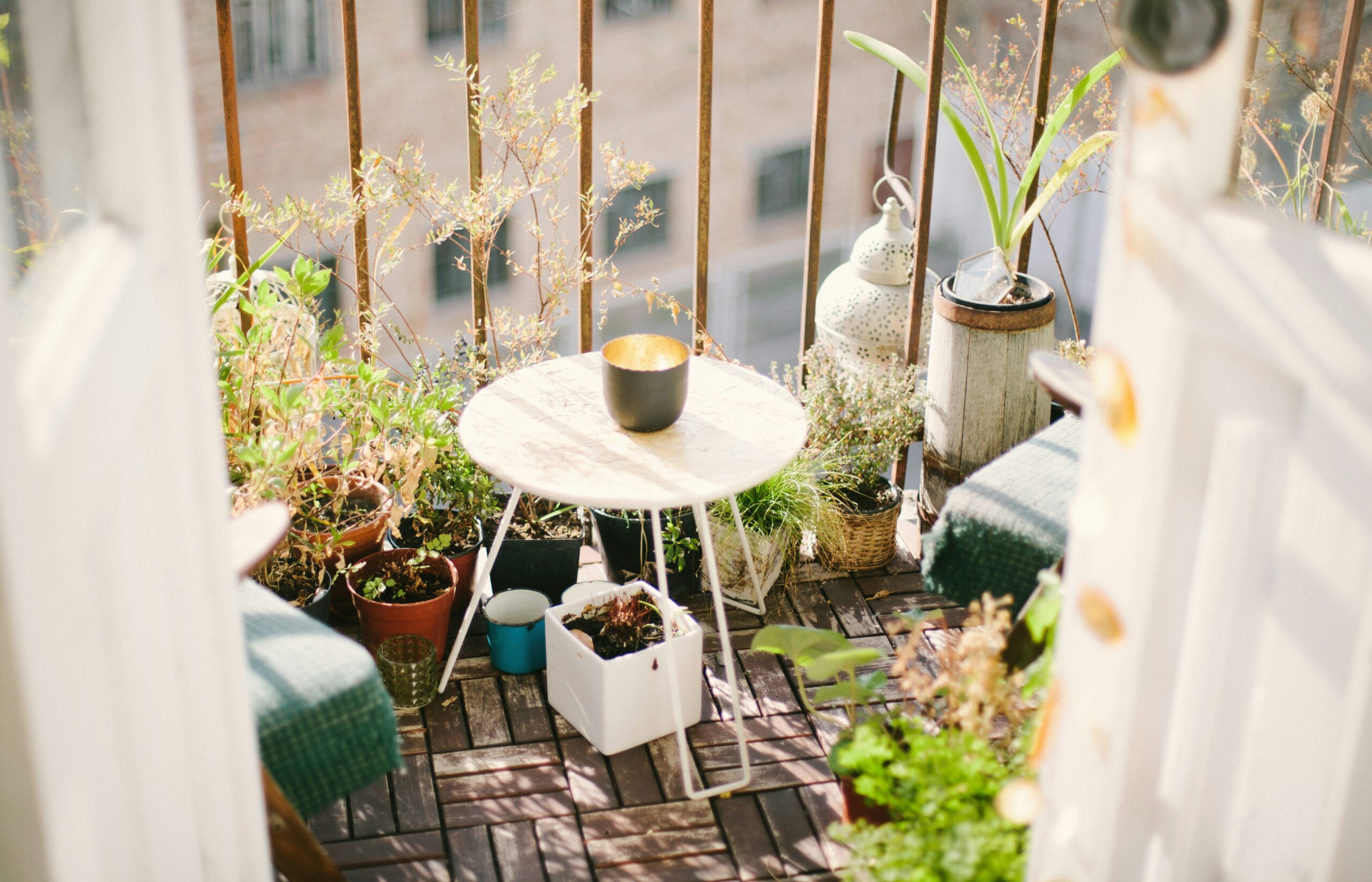Eco-Friendly Flooring Option #1: Bamboo

Bamboo flooring has gained popularity in recent years as a sustainable and eco-friendly option for homeowners. The material comes from fast-growing bamboo plants, which makes it a renewable resource compared to traditional hardwood. Bamboo floors are known for their durability and hardness, making them a suitable choice for high-traffic areas in homes.
In addition to being environmentally friendly, bamboo flooring offers a sleek and modern look that can complement various interior design styles. The natural grains and colors of bamboo add warmth and character to spaces, creating a welcoming and cozy atmosphere. Homeowners looking for a flooring option that is both aesthetically appealing and environmentally conscious may find bamboo flooring to be a perfect choice for their homes.
• Bamboo flooring is a sustainable option derived from fast-growing bamboo plants
• It is a renewable resource compared to traditional hardwood
• Known for its durability and hardness, making it suitable for high-traffic areas
• Offers a sleek and modern look that complements various interior design styles
• Natural grains and colors add warmth and character to spaces, creating a cozy atmosphere
Eco-Friendly Flooring Option #2: Cork
Cork flooring is a sustainable option that comes from the bark of cork oak trees. This material is harvested without harming the trees themselves, making it an environmentally friendly choice for flooring. Cork flooring is also biodegradable, adding to its eco-friendly appeal.
In addition to being a renewable resource, cork flooring offers other benefits. It is naturally resistant to mold, mildew, and insects, making it a durable and healthy choice for homes. Cork flooring is also known for its insulating properties, helping to keep spaces warm in winter and cool in summer.
• Cork flooring is a sustainable option that comes from the bark of cork oak trees
• Harvested without harming the trees themselves
• Biodegradable, adding to its eco-friendly appeal
• Naturally resistant to mold, mildew, and insects
• Durable and healthy choice for homes
• Known for its insulating properties, keeping spaces warm in winter and cool in summer
Eco-Friendly Flooring Option #3: Linoleum
Linoleum is a popular eco-friendly flooring option that is made from natural materials like linseed oil, pine resin, wood flour, and cork dust. These materials are highly renewable, making linoleum a sustainable choice for environmentally conscious consumers. Additionally, linoleum is known for its durability and low maintenance requirements, making it a long-lasting flooring option for both residential and commercial spaces.
Furthermore, linoleum comes in a wide range of colors and patterns, allowing for versatile design options to suit various interior styles. Its water-resistant properties make it ideal for areas prone to moisture, such as kitchens and bathrooms. Linoleum is also a comfortable flooring choice, as it has a soft underfoot feel and provides some insulation, assisting in maintaining a consistent indoor temperature.
• Linoleum is made from natural materials like linseed oil, pine resin, wood flour, and cork dust
• These materials are highly renewable
• Linoleum is a sustainable choice for environmentally conscious consumers
• Known for its durability and low maintenance requirements
• Suitable for both residential and commercial spaces
Furthermore, linoleum comes in a wide range of colors and patterns:
• Allows for versatile design options to suit various interior styles
• Water-resistant properties make it ideal for areas prone to moisture
• Comfortable flooring choice with a soft underfoot feel
• Provides some insulation, assisting in maintaining a consistent indoor temperature
Eco-Friendly Flooring Option #4: Reclaimed Wood
Reclaimed wood is a popular choice for eco-friendly flooring due to its sustainable nature. This type of flooring is made from wood that has been salvaged from various sources, such as old barns, factories, or other structures. By repurposing this wood, it helps to reduce the demand for new timber, thus conserving forests and reducing overall environmental impact.
In addition to its eco-friendly benefits, reclaimed wood flooring also adds a unique and rustic charm to any space. Each plank carries a story with it, showcasing its previous life and history. This type of flooring can bring warmth and character to a room, making it a standout feature while also promoting a more sustainable lifestyle.
• Reclaimed wood flooring is sustainable and reduces the demand for new timber
• Adds a unique and rustic charm to any space
• Each plank carries a story with it, showcasing its previous life and history
• Brings warmth and character to a room while promoting a more sustainable lifestyle
Eco-Friendly Flooring Option #5: Recycled Glass
Recycled glass flooring is a sustainable option that contributes to the reduction of waste in the environment. This type of flooring is made from crushed glass that is often sourced from recycled bottles or other glass products. By using recycled glass in flooring, it helps to divert glass from landfills and minimizes the consumption of new raw materials.
In addition to its eco-friendly benefits, recycled glass flooring offers a unique and stylish aesthetic appeal to any space. The glass particles can be mixed with resins or binders to create a durable and versatile flooring material. This type of flooring is available in a variety of colors and finishes, making it a customizable option for those looking to add a touch of sophistication while being environmentally conscious.
• Recycled glass flooring helps reduce waste in the environment
• Made from crushed glass sourced from recycled bottles or other glass products
• Diverts glass from landfills and minimizes consumption of new raw materials
• Offers a unique and stylish aesthetic appeal to any space
• Can be mixed with resins or binders to create durable and versatile flooring material
• Available in a variety of colors and finishes for customization options
Eco-Friendly Flooring Option #6: Salvaged Hardwood

Salvaged hardwood flooring offers a sustainable and eco-friendly option for homeowners looking to incorporate reclaimed materials into their living spaces. This type of flooring is sourced from previously used wood, such as old buildings, barns, or ships, that is carefully salvaged and repurposed for new installations. By opting for salvaged hardwood, individuals can not only reduce the demand for new timber but also contribute to the preservation of historical elements within the wood itself.
The unique character and patina of salvaged hardwood can add warmth and charm to any room, creating a distinct and inviting ambiance. Each piece of salvaged wood tells a story through its imperfections, knots, and natural variations, providing a one-of-a-kind look that cannot be replicated with newly manufactured flooring materials. Additionally, the durability and longevity of salvaged hardwood make it a practical choice for busy households seeking a sustainable flooring solution that stands the test of time.
• Salvaged hardwood flooring is sourced from previously used wood, such as old buildings, barns, or ships
• By opting for salvaged hardwood, individuals can reduce the demand for new timber
• Salvaged hardwood contributes to the preservation of historical elements within the wood itself
• The unique character and patina of salvaged hardwood can add warmth and charm to any room
• Each piece of salvaged wood tells a story through its imperfections, knots, and natural variations
• The durability and longevity of salvaged hardwood make it a practical choice for busy households
Eco-Friendly Flooring Option #7: Wool Carpet
Wool carpet is a sustainable flooring option that offers several benefits for eco-conscious consumers. Wool is a renewable resource that is biodegradable and recyclable, making it a great choice for those looking to reduce their environmental impact. Additionally, wool carpet is known for its durability and natural resistance to stains and odors, making it a practical and long-lasting flooring option for homes.
In terms of comfort and aesthetics, wool carpet provides a soft and luxurious feel underfoot, adding a cozy and inviting atmosphere to any space. With its natural insulation properties, wool carpet can help regulate the temperature in a room, keeping it warm in the winter and cool in the summer. Available in a variety of colors and textures, wool carpet can complement any interior design style while bringing warmth and elegance to the room.
• Wool carpet is a sustainable flooring option
• Renewable resource that is biodegradable and recyclable
• Durable and resistant to stains and odors
• Provides a soft and luxurious feel underfoot
• Natural insulation properties help regulate room temperature
• Available in a variety of colors and textures to complement any interior design style
Eco-Friendly Flooring Option #8: Rubber
Rubber flooring is a versatile and eco-friendly option that has gained popularity in various settings. Made from recycled rubber tires, this type of flooring is not only durable but also helps reduce landfill waste. Its shock-absorbent properties make it a practical choice for spaces where impact resistance is needed.
One of the key advantages of rubber flooring is its low maintenance requirements. It is easy to clean and resists stains, making it a suitable option for high-traffic areas in both residential and commercial settings. Additionally, rubber flooring is available in a range of colors and patterns, allowing for creative design possibilities while also contributing to a sustainable choice for environmentally conscious consumers.
• Rubber flooring is made from recycled rubber tires, reducing landfill waste
• Shock-absorbent properties make it ideal for spaces where impact resistance is needed
• Low maintenance requirements – easy to clean and resists stains
• Suitable for high-traffic areas in residential and commercial settings
• Available in a range of colors and patterns for creative design possibilities
Eco-Friendly Flooring Option #9: Concrete
Concrete is a durable and versatile eco-friendly flooring option that is gaining popularity in sustainable home design. It is made from natural materials such as cement, sand, and water, making it an environmentally friendly choice for those looking to reduce their carbon footprint. Concrete floors can also be finished with non-toxic sealants and stains, further enhancing its eco-friendly credentials.
One of the benefits of concrete flooring is its thermal properties, which can help regulate indoor temperatures and reduce energy consumption. Additionally, concrete is low-maintenance and long-lasting, making it a sustainable choice for homeowners looking for a flooring option that will stand the test of time. For those interested in a modern and minimalist aesthetic, concrete floors can also be customized with different finishes and designs to suit various interior styles.
• Concrete is made from natural materials such as cement, sand, and water
• Can be finished with non-toxic sealants and stains
• Offers thermal properties that help regulate indoor temperatures
• Low-maintenance and long-lasting option for sustainable homes
• Customizable with different finishes and designs for modern aesthetic
Eco-Friendly Flooring Option #10: Terrazzo
Terrazzo is a sustainable flooring option that consists of a mix of marble, quartz, granite, glass, or other materials, which are then poured in a binder like cement or epoxy resin. This mixture is then polished to create a smooth and durable surface that can last for many years with proper maintenance. Terrazzo is known for its versatility in design, allowing for unique patterns and color combinations to be incorporated into the flooring.
One of the key benefits of choosing terrazzo flooring is its sustainability. By utilizing recycled materials in its composition, terrazzo minimizes waste and reduces the environmental impact of flooring production. Additionally, the longevity of terrazzo means that it doesn’t need frequent replacement, further reducing the overall carbon footprint associated with flooring installations.
• Terrazzo is a sustainable flooring option made from a mix of recycled materials
• The durability of terrazzo means it can last for many years with proper maintenance
• Terrazzo allows for unique patterns and color combinations in design
• Choosing terrazzo helps minimize waste and reduce environmental impact in flooring production
• Longevity of terrazzo reduces the need for frequent replacements, lowering carbon footprint
Eco-Friendly Flooring Option #11: Glass Tile

Glass tiles are an innovative and eco-friendly flooring option that offer a sleek and modern aesthetic to any space. Made from recycled glass materials, these tiles are not only visually appealing but also sustainable. The production process of glass tiles consumes fewer resources and emits lower carbon emissions compared to traditional tile manufacturing methods, making them a great choice for environmentally conscious consumers.
In addition to being eco-friendly, glass tiles are durable and easy to maintain, making them a practical choice for high-traffic areas in a home or commercial setting. The smooth surface of glass tiles is resistant to stains and water, making them ideal for kitchens, bathrooms, and even outdoor spaces. Their reflective properties can also help to brighten up a room by enhancing natural light, creating a vibrant and welcoming atmosphere.
• Glass tiles are made from recycled glass materials
• Production process consumes fewer resources and emits lower carbon emissions
• Durable and easy to maintain, ideal for high-traffic areas
• Resistant to stains and water, perfect for kitchens, bathrooms, and outdoor spaces
• Reflective properties help brighten up a room by enhancing natural light
Eco-Friendly Flooring Option #12: Stone
Stone flooring is a durable and eco-friendly option for those seeking a long-lasting and sustainable flooring solution. With a variety of natural stone options available such as marble, granite, and limestone, stone flooring adds a touch of elegance and timeless beauty to any space. Its natural composition makes it a renewable resource that can be responsibly sourced, contributing to a more eco-conscious home environment.
In addition to its aesthetic appeal, stone flooring is also low maintenance and easy to clean, making it a practical choice for busy households. Its natural insulating properties help regulate indoor temperatures, reducing the need for excessive heating or cooling, thus supporting energy efficiency. Furthermore, stone flooring is hypoallergenic and resistant to allergens, mold, and bacteria, making it a healthy choice for individuals with respiratory concerns or allergies.
• Stone flooring is a durable and long-lasting option
• Variety of natural stone options available such as marble, granite, and limestone
• Adds elegance and timeless beauty to any space
• Renewable resource that can be responsibly sourced
• Low maintenance and easy to clean
• Natural insulating properties help regulate indoor temperatures
• Hypoallergenic and resistant to allergens, mold, and bacteria
Eco-Friendly Flooring Option #13: Leather
When considering eco-friendly flooring options, leather might not be the first material that comes to mind. However, sustainable leather flooring is gaining popularity for its durability and unique aesthetic appeal. Made from recycled leather remnants and treated with non-toxic dyes, this type of flooring provides a luxurious and environmentally conscious choice for eco-conscious consumers.
One of the key benefits of leather flooring is its longevity, as it can withstand heavy foot traffic and wear over time. Additionally, the natural qualities of leather offer insulation and a comfortable feel underfoot. With proper care and maintenance, leather flooring can last for many years, making it a sustainable choice for those looking to add a touch of sophistication to their living spaces while prioritizing environmental responsibility.
• Leather flooring is made from recycled leather remnants and treated with non-toxic dyes
• Offers a luxurious and unique aesthetic appeal
• Provides durability and can withstand heavy foot traffic
• Natural qualities of leather offer insulation and comfortable feel underfoot
• With proper care, leather flooring can last for many years
Eco-Friendly Flooring Option #14: Linoleum
Linoleum is a popular eco-friendly flooring option that is made from natural materials like linseed oil, cork powder, and wood flour. This type of flooring is known for its durability and low maintenance, making it a practical choice for both residential and commercial spaces. Linoleum is also available in a wide range of colors and patterns, allowing for versatile design options that can complement any interior style.
In addition to being environmentally friendly, linoleum is also hypoallergenic and resistant to bacteria and mold growth, making it a healthy choice for indoor spaces. Its resilience to moisture and stains makes it a suitable option for high-traffic areas like kitchens and bathrooms. With proper care and maintenance, linoleum flooring can last for many years, proving to be a cost-effective and sustainable flooring solution.
• Linoleum is made from natural materials like linseed oil, cork powder, and wood flour
• It is known for its durability and low maintenance
• Available in a wide range of colors and patterns for versatile design options
• Hypoallergenic and resistant to bacteria and mold growth
• Resilient to moisture and stains, making it suitable for high-traffic areas
• With proper care, linoleum flooring can last for many years
Eco-Friendly Flooring Option #15: Sustainable Hardwood
When it comes to sustainable hardwood flooring, choosing materials that are harvested responsibly is essential for reducing environmental impact. Sustainable hardwood ensures that for every tree harvested, another is replanted to maintain the balance of the ecosystem. This practice preserves forests for future generations and helps in combating deforestation, making it a preferred choice for eco-conscious homeowners.
In addition to its environmental benefits, sustainable hardwood flooring offers durability and timeless appeal. With proper care, this type of flooring can last for decades, making it a long-term investment for your home. The natural beauty and warmth of hardwood also add a touch of elegance to any space, creating a welcoming atmosphere that never goes out of style.
• Sustainable hardwood flooring is harvested responsibly, ensuring that for every tree cut down, another is replanted
• This practice helps in preserving forests for future generations and combating deforestation
• Sustainable hardwood flooring offers durability and timeless appeal
• With proper care, it can last for decades, making it a long-term investment for your home
• The natural beauty and warmth of hardwood add an elegant touch to any space
Eco-Friendly Flooring Option #16: Recycled Metal

Recycled metal flooring is a unique eco-friendly option that adds an industrial and modern touch to any space. Made from salvaged metal materials, this type of flooring is not only durable and long-lasting but also contributes to reducing waste and promoting sustainability in interior design. The raw and rugged appearance of recycled metal flooring can bring a bold and edgy element to both residential and commercial settings.
The versatility of recycled metal flooring allows it to be used in various rooms, from kitchens to offices, creating a stylish and environmentally conscious atmosphere. With its ability to be customized through different finishes and patterns, recycled metal flooring offers a one-of-a-kind aesthetic that can elevate the overall look of a room. Additionally, the low maintenance requirements of this type of flooring make it a practical choice for those looking to invest in a sustainable and visually striking flooring solution.
• Recycled metal flooring is a unique eco-friendly option that adds an industrial and modern touch to any space.
• Made from salvaged metal materials, this type of flooring is durable and long-lasting.
• Contributes to reducing waste and promoting sustainability in interior design.
• The raw and rugged appearance of recycled metal flooring can bring a bold and edgy element to both residential and commercial settings.
• Versatile enough to be used in various rooms, from kitchens to offices, creating a stylish and environmentally conscious atmosphere.
• Can be customized through different finishes and patterns for a one-of-a-kind aesthetic.
• Low maintenance requirements make it a practical choice for those looking for sustainable yet visually striking flooring solutions.
Eco-Friendly Flooring Option #17: Salvaged Tiles
When it comes to eco-friendly flooring options, salvaged tiles offer a unique and sustainable choice for homeowners looking to reduce their environmental impact. Salvaged tiles are typically sourced from old buildings, renovations, or demolition sites, providing a second life to materials that would otherwise end up in a landfill. By repurposing these tiles, not only are natural resources preserved, but the energy and emissions associated with manufacturing new tiles are also significantly reduced.
In addition to their eco-friendly benefits, salvaged tiles come in a variety of styles, colors, and materials, allowing homeowners to add a touch of character and history to their spaces. From vintage ceramic tiles to reclaimed wood or marble tiles, the options are diverse and can cater to different design preferences. By choosing salvaged tiles for flooring projects, individuals can not only create a unique and visually appealing environment but also contribute to the sustainable use of resources in the construction and design industry.
• Salvaged tiles are sourced from old buildings, renovations, or demolition sites
• Repurposing salvaged tiles helps preserve natural resources and reduce energy and emissions associated with manufacturing new tiles
• Salvaged tiles come in a variety of styles, colors, and materials
• Options include vintage ceramic tiles, reclaimed wood, and marble tiles
• Choosing salvaged tiles can add character and history to spaces while contributing to sustainable resource use in the construction industry
Eco-Friendly Flooring Option #18: Jute
Another eco-friendly flooring option to consider is Jute. Jute is a natural fiber that comes from the jute plant and is both biodegradable and renewable. Its durability makes it a great choice for high-traffic areas in your home.
Aside from being eco-friendly, Jute flooring also offers a unique and natural aesthetic to your living space. Its neutral tones and subtle texture can complement a variety of interior design styles, adding a touch of warmth and sophistication to any room.
• Jute is a natural fiber that comes from the jute plant
• It is biodegradable and renewable
• Durable, making it suitable for high-traffic areas in your home
• Offers a unique and natural aesthetic to living spaces
• Neutral tones and subtle texture can complement various interior design styles
Eco-Friendly Flooring Option #19: Seagrass
Seagrass flooring is a natural and eco-friendly option that offers a unique, organic look to any space. Harvested from sustainable seagrass plants, this flooring material is biodegradable and renewable, making it a popular choice among environmentally-conscious consumers. Seagrass flooring is known for its durability and resistance to stains, making it a practical option for high-traffic areas in a home or office.
In addition to its eco-friendly benefits, seagrass flooring is also low-maintenance and easy to clean, requiring only regular vacuuming or sweeping to keep it looking fresh and vibrant. Its natural fibers add warmth and texture to a room, creating a cozy and inviting atmosphere. Whether used in a living room, bedroom, or hallway, seagrass flooring adds a touch of nature to any interior space, while also contributing to a greener, more sustainable lifestyle.
• Seagrass flooring is harvested from sustainable seagrass plants
• Biodegradable and renewable material
• Durable and resistant to stains, making it ideal for high-traffic areas
• Low-maintenance and easy to clean with regular vacuuming or sweeping
• Natural fibers add warmth and texture to a room
• Creates a cozy and inviting atmosphere in any space
• Adds a touch of nature to interior spaces
• Contributes to a greener, more sustainable lifestyle
Eco-Friendly Flooring Option #20: Paper-based Flooring
Paper-based flooring is a unique and eco-friendly option that is gaining popularity among homeowners looking for sustainable choices. Made from recycled paper materials, this type of flooring offers a stylish look while also being environmentally conscious. It comes in various finishes and styles, allowing for versatility in design options to suit different preferences and decor themes.
One of the key benefits of paper-based flooring is its durability and strength. Despite being made from paper, this type of flooring is engineered to withstand heavy foot traffic and everyday wear and tear. Additionally, it is easy to maintain and clean, making it a low-maintenance option for busy households. The use of recycled materials in its production also contributes to reducing waste and promoting a greener lifestyle.
• Paper-based flooring is made from recycled paper materials
• Offers a stylish look while being environmentally conscious
• Comes in various finishes and styles for versatility in design options
• Durable and strong, able to withstand heavy foot traffic and wear and tear
• Easy to maintain and clean, making it a low-maintenance option
• Production using recycled materials helps reduce waste



